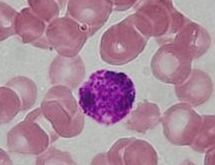Basophil: Difference between revisions
No edit summary |
CSV import |
||
| Line 43: | Line 43: | ||
[[Category:Granulocytes]] | [[Category:Granulocytes]] | ||
[[Category:Human cells]] | [[Category:Human cells]] | ||
<gallery> | |||
File:Blausen 0077 Basophil (crop).png|Basophil | |||
File:Basophile-9.JPG|Basophil | |||
</gallery> | |||
Latest revision as of 01:00, 20 February 2025
Basophils are a type of white blood cell and are classified under granulocytes, which are characterized by the presence of granules in their cytoplasm. Basophils are the least common of the granulocytes, comprising about 0.01% to 0.3% of circulating white blood cells. Despite their low numbers, they play a crucial role in the immune response, especially in inflammation and allergic reactions.




Morphology and Function[edit]
Basophils are round cells, approximately 12–15 micrometers in diameter, with a segmented nucleus. They are filled with large, coarse, bluish-black granules which obscure the nucleus. These granules contain:
- Histamine: A compound that increases blood flow to the affected area, leading to the common symptoms of an allergic reaction such as redness, heat, and swelling.
- Heparin: An anticoagulant that prevents blood from clotting too quickly.
- Leukotrienes: Lipids that mediate inflammatory responses.
The primary function of basophils is to participate in the body's immune response against parasites, especially parasitic worms. They also have a significant role in allergic reactions, asthma, and other inflammatory conditions. When an allergen enters the body, basophils release their granular contents into the bloodstream, leading to the symptoms of an allergic reaction.
Development[edit]
Basophils develop from stem cells in the bone marrow. The process, known as hematopoiesis, involves several stages of differentiation. Once mature, basophils leave the bone marrow and enter the bloodstream, where they circulate for a few hours before migrating into tissues throughout the body.
Clinical Significance[edit]
Abnormal basophil levels can be an indication of various diseases:
- Basophilia (increased basophil count): Can be seen in myeloproliferative disorders, such as chronic myeloid leukemia, and in some forms of inflammatory conditions like rheumatoid arthritis.
- Basopenia (decreased basophil count): Less commonly noted but can occur with hyperthyroidism, acute infections, and after a severe allergic reaction.
Interactions with Other Cells[edit]
Basophils interact with other immune cells like T cells. They can present antigens to T cells and secrete cytokines that regulate the function of these and other immune cells.
See also[edit]
- Granulocytes
- White blood cell
- Mast cell - Another cell type involved in allergic responses.
External links[edit]
- Basophil Information - American Society of Hematology
- International Immunology Foundation - Comprehensive information on immune cells.
|
|
|
| Myeloid blood cells and plasma | ||||||
|---|---|---|---|---|---|---|
|
| Lymphocytic adaptive immune system and complement | ||||||||||||||||
|---|---|---|---|---|---|---|---|---|---|---|---|---|---|---|---|---|
|
-
Basophil
-
Basophil




